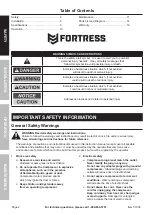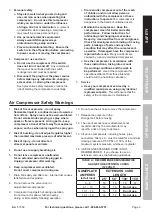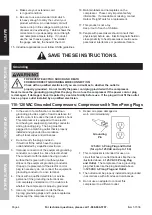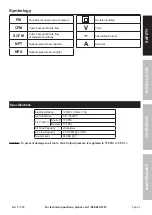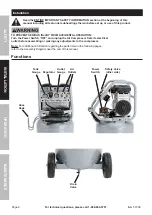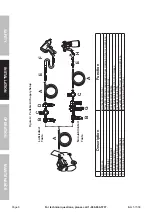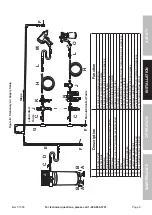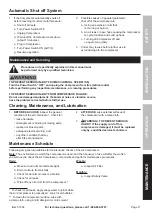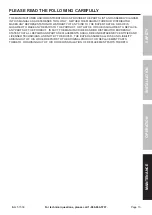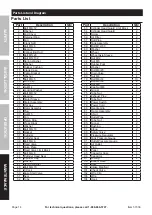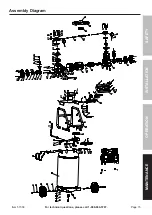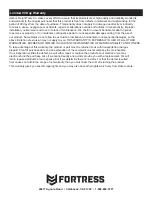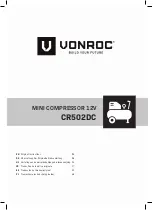
Page 3
For technical questions, please call 1-888-866-5797.
Item 57336
SA
FE
TY
OP
ERA
TI
O
N
MAINT
ENANC
E
IN
ST
ALLA
TI
O
N
3.
Personal safety
a.
Stay alert, watch what you are doing and
use common sense when operating this
compressor. Do not use this compressor
while you are tired or under the influence
of drugs, alcohol or medication.
A moment
of inattention while operating a compressor
may result in serious personal injury.
b.
Use personal protective equipment.
Always wear ANSI-approved eye
protection during setup and use.
c.
Prevent unintentional starting. Ensure the
switch is in the off-position before connecting
to power source or moving the compressor.
4.
Compressor use and care
a.
Do not use the compressor if the switch
does not turn it on and off.
Any compressor
that cannot be controlled with the switch
is dangerous and must be repaired.
b.
Disconnect the plug from the power source
before making any adjustments, changing
accessories, or storing the compressor.
Such preventive safety measures reduce the
risk of starting the compressor accidentally.
c.
Store an idle compressor out of the reach
of children and do not allow persons
unfamiliar with the compressor or these
instructions to operate it.
A compressor is
dangerous in the hands of untrained users.
d.
Maintain the compressor. Keep the
compressor clean for better and safer
performance. Follow instructions for
lubricating and changing accessories.
Keep dry, clean and free from oil and grease.
Check for misalignment or binding of moving
parts, breakage of parts and any other
condition that may affect the compressor’s
operation. If damaged, have the compressor
repaired before use.
Many accidents are
caused by a poorly maintained compressor.
e.
Use the compressor in accordance with
these instructions, taking into account
the working conditions and the work to
be performed.
Use of the compressor for
operations different from those intended
could result in a hazardous situation.
5.
Service
a.
Have your compressor serviced by a
qualified repair person using only identical
replacement parts.
This will ensure that the
safety of the compressor is maintained.
Air Compressor Safety Warnings
1.
Risk of fire or explosion - do not spray
flammable liquid in a confined area or towards a
hot surface. Spray area must be well-ventilated.
Do not smoke while spraying or spray where
spark or flame is present. Arcing parts - keep
compressor at least 20 feet away from explosive
vapors, such as when spraying with a spray gun.
2.
Risk of bursting - do not adjust regulator higher
than marked maximum pressure of attachment.
3.
Risk of injury - do not direct air
stream at people or animals.
4.
Do not use to supply breathing air.
5.
Do not leave compressor unattended
for an extended period while plugged in.
Unplug compressor after working.
6.
Keep compressor well-ventilated.
Do not cover compressor during use.
7. Drain Tank daily and after use. Internal rust causes
tank failure and explosion.
8. Do not remove the valve cover or
adjust internal components.
9. Compressor head gets hot during operation.
Do not touch it or allow children nearby
during or immediately following operation.
10. Do not use the air hose to move the compressor.
11. Release the pressure in the
storage tank before moving.
12. The use of accessories or attachments not
recommended by the manufacturer may
result in a risk of injury to persons.
13. All air line components, including hoses, pipe,
connectors, filters, etc., must be rated for a minimum
working pressure of 150 PSI, or 150% of the
maximum system pressure, whichever is greater.
14. USE OF AN EXTENSION CORD IS NOT
RECOMMENDED. If you choose to use an
extension cord, use the following guidelines:
TABLE A: RECOMMENDED MINIMUM WIRE
GAUGE FOR EXTENSION CORDS
(120 VOLT)
NAMEPLATE
AMPERES
(at full load)
EXTENSION CORD
LENGTH
25
′
50
′
100
′
150
′
0 – 6
18
16
16
14
6.1 – 10
18
16
Do not use.
10.1 – 12
16
16
Do not use.
12.1 – 16
14
12
Do not use.


